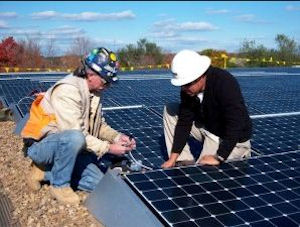Thanks to a new law making it easier for non-utilities to sell solar electricity, backers of solar power are viewing the future with cautious optimism.
By Andrew Jenner
Virginia gets enough sunshine, relative to other states, to give it better-than-average potential for solar energy development. A 2012 study by the National Renewable Energy Laboratory estimated its potential solar energy generation capacity at 1.9 million gigawatt hours – about 17 times the state’s total annual electricity consumption.
This potential is far from reality, however. With just 10 MW of installed solar photovoltaic generation capacity, the largest being a new 2.1-MW array at the Norfolk Naval Station, Virginia ranks far behind other eastern states with more progressive solar energy policy. (New Jersey alone had 955 MW installed by the end of 2012.)
One major reason is that the state has no mandatory Renewable Portfolio Standard (RPS), due both to the considerable lobbying efforts of the state’s powerful electric utilities and a political climate generally unfavorable to new regulatory mandates. Since Virginia adopted a voluntary RPS program in 2007, the utility lobby snuffed out legislative attempts to set mandatory RPS goals and to allow renewable energy companies to sell power directly to individual customers from behind-the-meter wind or solar installations.
Over the past two years, Dominion, the state’s largest investor-owned utility, also has blocked several solar projects financed with power purchase agreements, or PPAs, arguing that the arrangement infringes on its exclusive right to sell power in its franchise territory. The PPA model, which allows nonprofit entities to capture important federal tax benefits through a for-profit energy company, has been key to development of the solar industry in other states.
In January, however, renewable energy advocates were pleasantly surprised when Dominion reversed course and put its considerable weight behind legislation that allows for limited use of PPAs in the state. In March Governor Bob McDonnell signed the bills, which creates a pilot program for solar and wind energy projects in Dominion’s franchise territory that are financed through third-party PPAs,
Solar energy advocates in Virginia are hopeful that the industry soon will make up lost ground. “[This program] is a great opportunity for Virginia customers to be able to finally take advantage of the financing model that is driving most new solar installations nationwide,” said Ivy Main, the vice-chair of the Sierra Club’s Virginia Chapter.
Solar developers within the state also are excited about the future. Mike Healy, a national board member of the Solar Energy Industry Association, called PPAs “critically important” mechanisms for stimulating private investment into the solar market, and applauded the pending change in Virginia as precedent-setting within the state.
“The outlook for this year is a really good one,” said Tony Smith, president and CEO of Secure Futures, a Virginia company that designs, finances and installs solar arrays for universities and other tax-exempt institutions and organizations.
Dominion’s support for the PPA model came as both a surprise and a relief to Smith and other solar supporters, given the utility’s recent actions to block these very same PPAs. Over the past two years, Secure Futures has been at the forefront of this conflict in Virginia, and has played an unexpected role of energy policy activist as it has struggled to find ways to bring projects online without using PPA financing. Read more.



